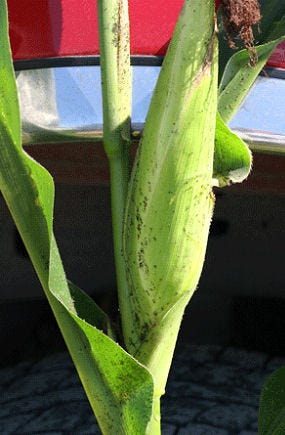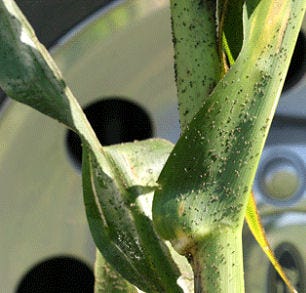
Beginning last week, Iowa State University Extension entomologist Erin Hodgson and some of the ISU Extension field agronomists around the state began hearing about an aphid explosion--in corn! Aphids have been invading Iowa soybean fields in recent years, but you don't often hear about them attacking corn.

Corn aphids infesting the ear and above the ear leaf.
For the last three to four years, certain areas in Iowa have had serious problems with aphids infesting corn in August. The areas having problems right now include the northeast and northwest corners of Iowa and west central Iowa. "Some of these heavily-infested fields were sprayed with an insecticide earlier this year," says Hodgson. "From my observations this past week, I noticed aggregated colonies at the end rows."
In years past, corn leaf aphid could be a problem during tasseling time. "This species aggregated around the ear and silks, and sometimes their honeydew production interfered with pollination," says Hodgson. "But natural enemies and the environment rarely let them build up past July. So economic thresholds have only been determined for aphids around tasseling and mostly targeted to fields during drought-stressed summers."
Aphids are infesting corn later in summer, building up aphid population
Now, it seems aphids are colonizing corn later in the summer and are building up to striking levels, she explains. They can be found at the base of the stalk, around the ear and sometimes building up colonies above the ear leaf.
Aphids in corn can build large colonies, sometimes exceeding 2,000 per plant.

Aphids in corn can build large colonies, sometimes exceeding 2,000 per plant.
"One important observation I've made is that most fields have two aphids species - corn leaf aphid and bird cherry oat aphid," says Hodgson. "They are closely related and look very similar in size and color. The bird cherry oat aphid has an orange-red saddle between the cornicles. Other aphid species can also be found, including greenbug and English grain aphid, but are not as common in corn this year. Species identification isn't that critical for management at this point (an aphid is an aphid). You can see more than one species in a field and even on a single corn plant.
Currently, there are no treatment thresholds for aphids in corn past tasseling, says Hodgson. But regular sampling of fields will help you make educated decisions about applying a foliar application of insecticide at this time. Hodgson offers the following considerations to make before applying an insecticide for aphids in corn:
Are 80% of the plants infested with aphids?
Do most of the ears have aphids? What about the ear leaf and above?
How long has the field been infested and is the density increasing? Sample field-wide (30 plants for every 50 acres) to determine the average density.
Do you see honeydew or sooty mold on the stalk, leaves or ear?
Are you seeing winged aphids or nymphs with wing pads? This may be a sign of migration out of the field.
Is the field under drought stress? Dry weather will amplify potential feeding damage to corn.
Do you see any bloated, off-color aphids under humid conditions? Natural fungi can quickly wipe out aphids in field crops.
What is the corn growth stage? Fields reaching hard dent may be past the point of a justified insecticide.
Some insecticides have a 60-day pre-harvest interval. Check the label and calendar.
Get good coverage of the application - ideally droplets should make contact with the aphids for a quick knockdown. Don't expect residual to protect the corn from fluid feeders.
Hodgson adds, "I strongly encourage you to leave an untreated check strip or two in fields that you spray. Try to leave a strip that is a fair comparison to the majority of the field - not just the stunted corn around the field edge. If you decide to treat for aphids in corn, I would like to hear about the yield comparisons. Your pooled data will help me formulate treatment guidelines for the future."
About the Author(s)
You May Also Like




